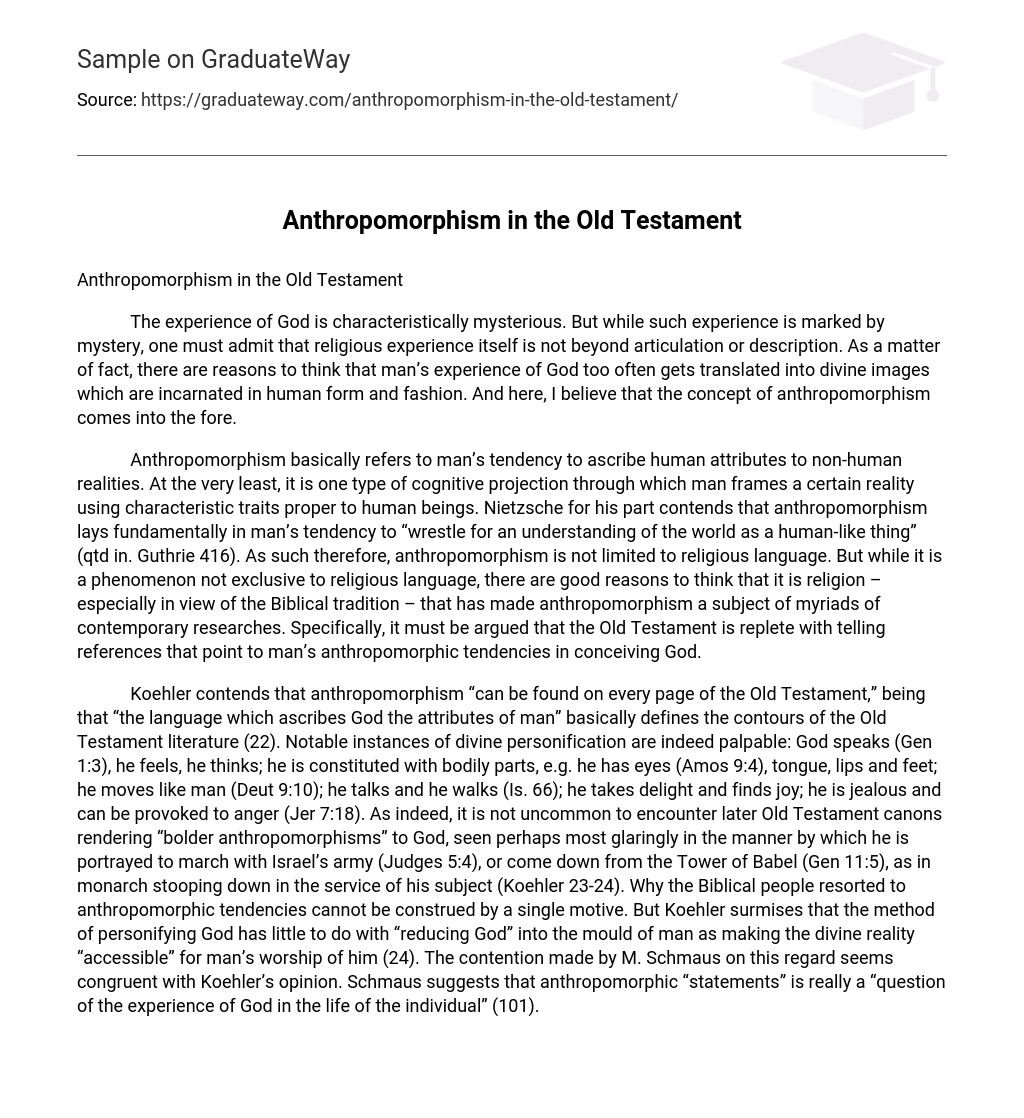The experience of God is characteristically mysterious. But while such experience is marked by mystery, one must admit that religious experience itself is not beyond articulation or description. As a matter of fact, there are reasons to think that man’s experience of God too often gets translated into divine images which are incarnated in human form and fashion. And here, I believe that the concept of anthropomorphism comes into the fore.
Anthropomorphism basically refers to man’s tendency to ascribe human attributes to non-human realities. At the very least, it is one type of cognitive projection through which man frames a certain reality using characteristic traits proper to human beings. Nietzsche for his part contends that anthropomorphism lays fundamentally in man’s tendency to “wrestle for an understanding of the world as a human-like thing” (qtd in. Guthrie 416). As such therefore, anthropomorphism is not limited to religious language. But while it is a phenomenon not exclusive to religious language, there are good reasons to think that it is religion – especially in view of the Biblical tradition – that has made anthropomorphism a subject of myriads of contemporary researches. Specifically, it must be argued that the Old Testament is replete with telling references that point to man’s anthropomorphic tendencies in conceiving God.
Koehler contends that anthropomorphism “can be found on every page of the Old Testament,” being that “the language which ascribes God the attributes of man” basically defines the contours of the Old Testament literature (22). Notable instances of divine personification are indeed palpable: God speaks (Gen 1:3), he feels, he thinks; he is constituted with bodily parts, e.g. he has eyes (Amos 9:4), tongue, lips and feet; he moves like man (Deut 9:10); he talks and he walks (Is. 66); he takes delight and finds joy; he is jealous and can be provoked to anger (Jer 7:18). As indeed, it is not uncommon to encounter later Old Testament canons rendering “bolder anthropomorphisms” to God, seen perhaps most glaringly in the manner by which he is portrayed to march with Israel’s army (Judges 5:4), or come down from the Tower of Babel (Gen 11:5), as in monarch stooping down in the service of his subject (Koehler 23-24). Why the Biblical people resorted to anthropomorphic tendencies cannot be construed by a single motive. But Koehler surmises that the method of personifying God has little to do with “reducing God” into the mould of man as making the divine reality “accessible” for man’s worship of him (24). The contention made by M. Schmaus on this regard seems congruent with Koehler’s opinion. Schmaus suggests that anthropomorphic “statements” is really a “question of the experience of God in the life of the individual” (101).
By way of brief summary, it may be good to point that anthropomorphism is really man’s intuitive ascent to employ concrete human models in the unique manner by which he grasps reality. While not really an exclusively religious phenomenon, the Old Testament of the Bible nevertheless acts a single most valuable chest of references that point to many anthropomorphic tendencies; the reason for this, as it was argued, lies in man’s desire to portray God as someone understandable and recognizable. In my own view, anthropomorphism is always a helpful way to enrich one’s faith. Because our faith is shaped by the experiences that we encounter, I therefore believe that a suitable image of God is necessary in order to nurture a faith that is not fed by endless memorization of abstract doctrines, but is enriched by concrete religious experiences. If not with anthropomorphisms, I do not think we can ever arrive at having a faith which strikes the heart of our humanity, or speaks volumes for our own experiences of joy, pain, delight or sorrow.
References
Guthrie, Stewart. “Religion: What Is It?” Journal for the Scientific Study of Religion, Volume 35, Number 4, 1996.
Koehler, Ludwig. Old Testament Theology. London: James Clarke and Company, 2002.
Schmaus, Michael, Dogma, Volume 2, God and Creation. London: Sheed and Ward, Inc., 1969.





